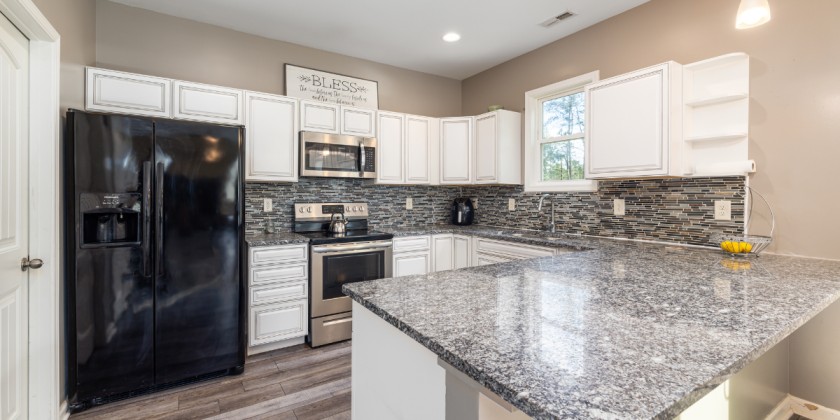An outdoor kitchen is more than just a place to cook, it’s a space where you gather with friends, enjoy good weather, and create lasting memories. One of the most important parts of designing an outdoor kitchen is choosing the right countertop.
It needs to look great, handle the elements, and be easy to maintain. I’ve helped many homeowners plan their outdoor spaces, and one thing is always true: the countertop can make or break the whole vibe.
In this guide, I’ll walk you through some of the best outdoor kitchen countertop ideas that are not only durable but also stylish and practical for every type of backyard setup.
Factors to Consider Before Choosing Outdoor Kitchen Countertops
Before jumping into materials and designs, it’s important to understand what actually makes a good outdoor kitchen countertop. Trust me, it’s not just about looks, there’s a lot more that goes into the decision. Unlike indoor kitchens, outdoor countertops have to deal with weather changes, direct sunlight, and sometimes even snow or rain, depending on where you live.
Here are a few key things to think about:
- Weather Resistance
Your countertop should be able to handle sun, rain, and temperature changes without cracking or fading. - Heat Tolerance
Since you’ll be grilling or cooking nearby, the surface needs to resist high heat without damage. - Maintenance
Some materials need regular sealing or cleaning. If you’re like me and prefer low-maintenance options, this matters a lot. - Aesthetic Fit
You want a surface that matches the vibe of your outdoor space—whether it’s rustic, modern, or beachy. - Budget
Let’s be real, price plays a big role. Some materials look amazing but can be expensive to install and maintain over time.
Getting clear on these basics will help you make a smarter, more lasting choice. Now, let’s dive into the best countertop materials you can choose for your outdoor kitchen.
Best Outdoor Kitchen Countertop Materials
Now that you know what to look for, let’s talk about the materials that actually work well outdoors. I’ve seen all kinds of setups, from small patio kitchens to full outdoor bars, and the right countertop can really elevate the whole space. Here are some of the most popular and reliable materials, each with its own pros and cons.
1. Granite Countertops
Granite remains one of the most elegant choices for outdoor kitchen countertops. It brings a natural, high-end look to your space and handles outdoor conditions like a champ. Whether you’re working with a large patio kitchen or just a small grill station, granite can add that polished feel without clashing with nature.
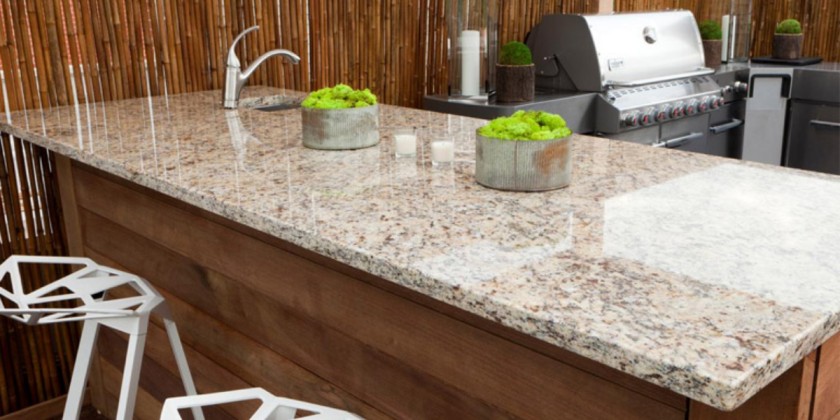
I’ve seen it used beautifully in both rustic and modern backyard designs. Plus, the natural stone patterns give each slab a unique character, which I personally love.
2. Concrete Countertops
If you’re after a sleek, custom look, concrete is one of the most versatile options out there. You can shape it exactly to fit your outdoor layout, add color, or even embed textures and patterns. I’ve had clients who went all-in with concrete to match a modern patio, and the result was stunning, minimalist yet bold.
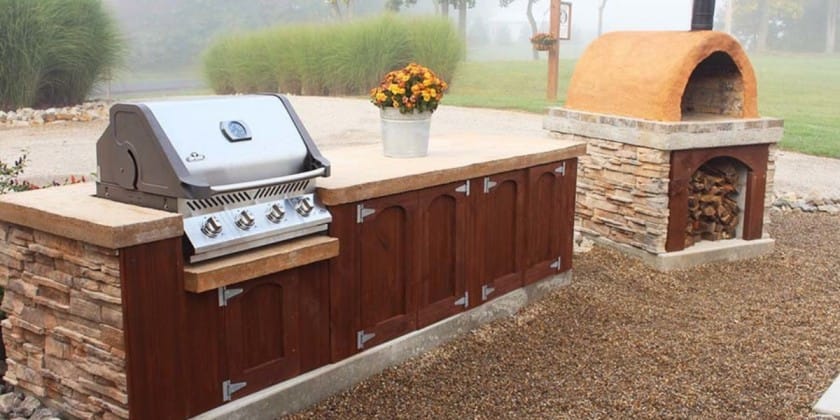
It’s also a great choice if you want to incorporate other features like built-in sinks or fire elements seamlessly into the design.
3. Tile Countertops
Tile might seem like a simple solution, but it can really open up your design possibilities. With so many colors, shapes, and patterns to choose from, tile gives you the freedom to create a truly personal look.
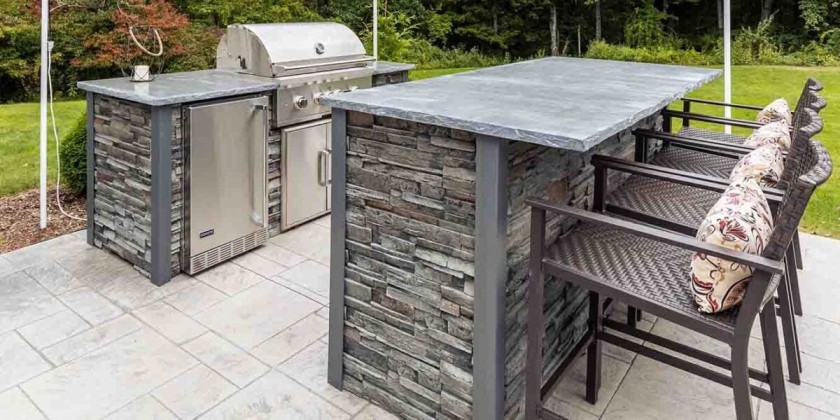
I’ve seen Mediterranean-style outdoor kitchens with vibrant blue tiles that instantly make the space feel like a coastal retreat. It’s also a great option for those who want a DIY-friendly project or something more budget-conscious without sacrificing style.
4. Stainless Steel Countertops
If you’re aiming for a clean, modern outdoor kitchen, especially one that complements a sleek grill setup, stainless steel is a standout choice. It brings that professional chef vibe to your backyard, and it fits beautifully in minimalist or urban-style outdoor designs.
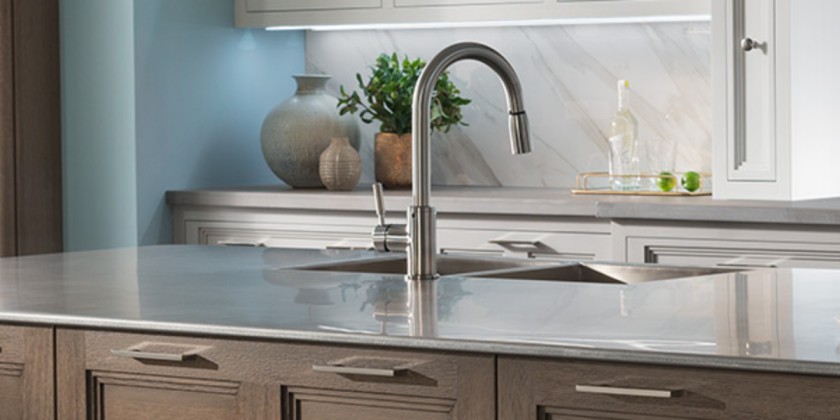
I’ve seen it work really well in smaller patios too, where reflective surfaces help the space feel open and polished. Stainless steel is also easy to wipe down after cooking, which is always a win in my book.
5. Soapstone Countertops
Soapstone has a smooth, velvety look that gives outdoor kitchens a more relaxed, organic feel. It usually comes in darker shades like charcoal or deep gray, which pair nicely with wood accents, natural stone walls, or even brick ovens.

One thing I’ve always appreciated about soapstone is how timeless it looks, it doesn’t try too hard, but it definitely leaves an impression. It’s a great option if you want something subtle but stylish.
6. Porcelain Slabs
Porcelain might not be as widely known in outdoor kitchen design, but it’s quickly gaining popularity, and for good reason. It’s sleek, low-maintenance, and available in a wide range of finishes, including options that mimic natural stone or concrete.
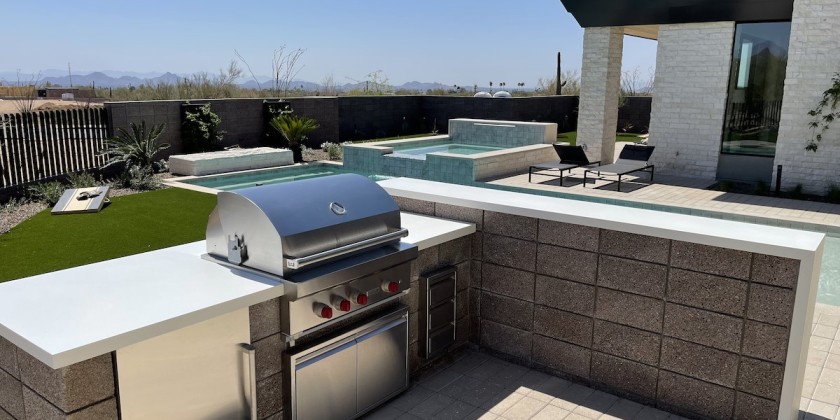
I’ve seen porcelain used in high-end outdoor kitchens where homeowners wanted that luxurious, high-design aesthetic without the upkeep. It’s also incredibly thin and lightweight, which can be helpful if you’re building on a deck or rooftop.
Budget-Friendly Kitchen Countertop Ideas
Creating a beautiful outdoor kitchen doesn’t always require a big budget. In fact, some of the most charming setups I’ve seen were built using smart, affordable materials and a bit of DIY spirit.
If you’re looking to cut costs without cutting style, here are a few practical ideas that can help you build your dream space on a budget.
1. Sealed or Treated Wood Countertops
Wood might not sound like an obvious choice for outdoor use, but with the right treatment, it can be both durable and stunning. Think reclaimed wood, butcher block, or even pressure-treated lumber, sealed to handle moisture and UV exposure.
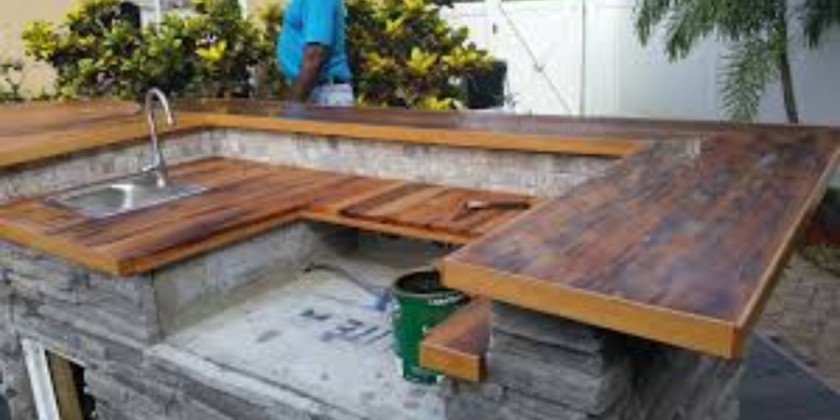
I’ve seen homeowners use wood for bar tops, buffet areas, or side counters under pergolas or covered patios. It brings a natural, warm touch that pairs beautifully with brick, stone, or greenery. Just be sure to reseal it regularly to keep it looking fresh.
2. DIY Concrete Countertops
Concrete is one of the most budget-friendly ways to get a custom, modern look outdoors, especially if you’re willing to do some of the work yourself. With a simple mold, a bag of mix, and a weekend of effort, you can pour your own concrete countertop.
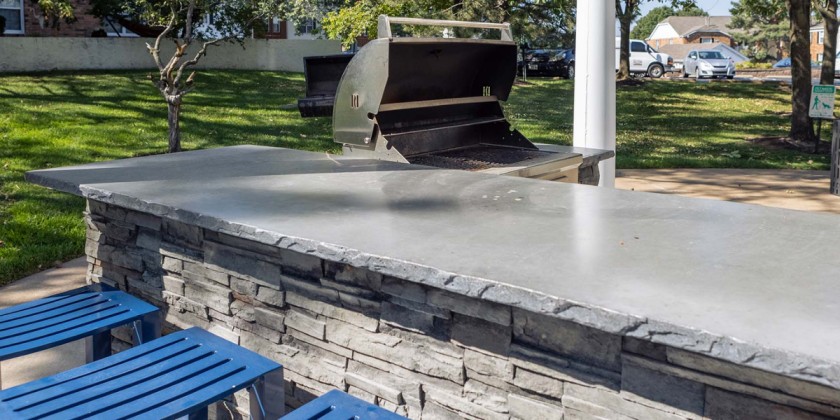
You can even add pigment or texture to give it a unique finish. I’ve worked on projects where homeowners created stunning concrete counters for a fraction of the cost of stone, and the results honestly looked high-end.
3. Prefabricated Countertop Kits
If DIY isn’t your thing, prefab kits are a great middle ground. These come in standard sizes and ready-to-install formats, often using materials like composite stone or pre-assembled tiles.

They’re ideal for outdoor kitchen islands or simple straight-line counters. What’s great about these kits is how much time and labor they save, plus, you get a clean finish with minimal hassle.
4. Tile Countertops
Tile remains one of the most flexible and affordable options out there. With ceramic or porcelain tiles, you can get creative with patterns, colors, and textures that bring real personality to your kitchen.
Whether you’re going for a Mediterranean, boho, or classic look, there’s a tile for that. One of my favorite parts of using tile is how much control you have over the design, even on a tight budget. Just make sure you use outdoor-rated tile and keep the grout sealed.
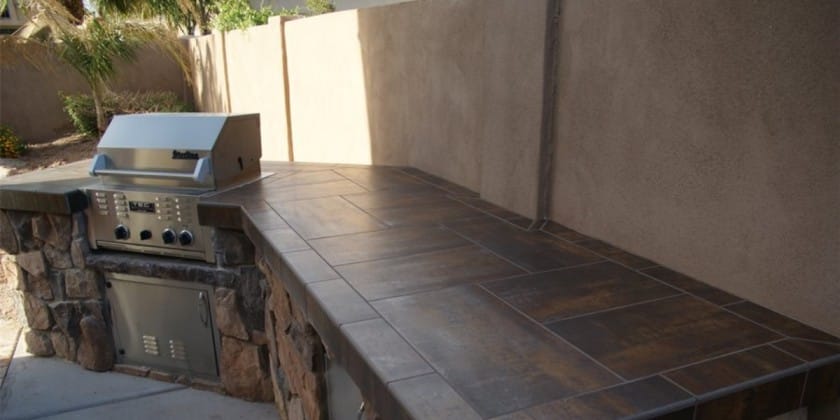
Budget-friendly doesn’t have to mean basic. With a little creativity and a clear vision, you can build an outdoor kitchen that looks like a million bucks, even if you didn’t spend anywhere near that.
Design Ideas and Layout Tips
Choosing the right countertop material is only half the story, how you use it in your layout and design is what really brings your outdoor kitchen to life.
Over the years, I’ve noticed that even a simple material can look incredible when paired with the right layout and surrounding features. Whether you’re working with a compact patio or a sprawling backyard, there are plenty of ways to make your countertop the star of the space.
One idea I always suggest is mixing materials. For example, you can use granite or soapstone for your main prep area and add a wooden butcher block section for serving or drinks. This kind of contrast not only looks great but also helps define different zones in your outdoor kitchen.
L-shaped and U-shaped layouts are also very popular and practical. They give you lots of surface area for cooking, prepping, and even hosting, while keeping everything within reach. If space is limited, a straight-line kitchen along a wall or fence can still pack in plenty of functionality with the right countertop and storage setup.
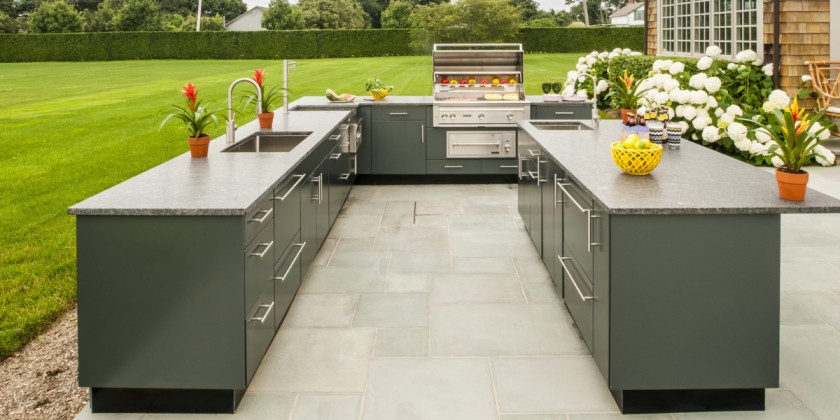
Another trend I’ve seen growing is integrating built-in grill stations, sinks, or pizza ovens into the countertop design. It creates a seamless, professional look that also makes cooking outdoors feel like second nature.
Lighting and accessories also matter—try adding under-counter LED strips or hanging pendant lights above a bar-style counter. These small touches make the kitchen feel more like a natural extension of your home rather than just an outdoor add-on.
Maintenance Tips for Outdoor Countertops
Start with simple cleaning. After each use, wipe down your counters with a mild, non-abrasive cleaner. For natural stone surfaces like granite or soapstone, use a stone-safe cleaner and apply a sealant once or twice a year to guard against stains and moisture.
Concrete counters also need sealing, especially if they’re custom-poured. It keeps the surface protected from cracking or fading. If you’re using wood countertops, make sure they’re sealed with a weatherproof finish, and try to keep them covered when not in use. Sun and rain can wear them down quickly without protection.
Stainless steel is easy to maintain, just keep an eye on water spots and give it a polish now and then to keep it looking sleek. And with tile countertops, don’t forget about the grout. Outdoor grout needs occasional sealing, too, to keep it from absorbing moisture or getting dirty.
If your area gets cold winters, consider covering your counters during off-season months. A good quality cover goes a long way in preserving the life and finish of any material.
FAQs
Most outdoor kitchen counters follow the same standard as indoor ones: around 36 inches for prep and cooking surfaces, and 42 inches for bar-height counters. Adjust according to your needs and seating style.
While it’s not required, covering your countertops when not in use will significantly extend their life, especially in extreme heat, rain, or snowy conditions. This is particularly helpful for wood, tile, or concrete surfaces.
It depends on the material. Tile and concrete can be DIY-friendly with the right tools and patience. Granite, stainless steel, or porcelain slabs usually require pro installation to ensure a clean, durable finish.
Conclusion
Designing your outdoor kitchen is an exciting project, and the right countertop can really bring the whole space together. Whether you’re going for a luxurious stone finish, a sleek modern vibe, or a creative DIY setup, there’s no shortage of ideas to fit your style and budget. From granite and concrete to tile and wood, each material brings something unique to the table, literally.
As someone who’s seen these ideas come to life in all kinds of backyard setups, I can say this: take your time, think about how you’ll actually use the space, and don’t be afraid to get a little creative. A well-chosen countertop doesn’t just make outdoor cooking easier, it makes your outdoor space feel like home.

